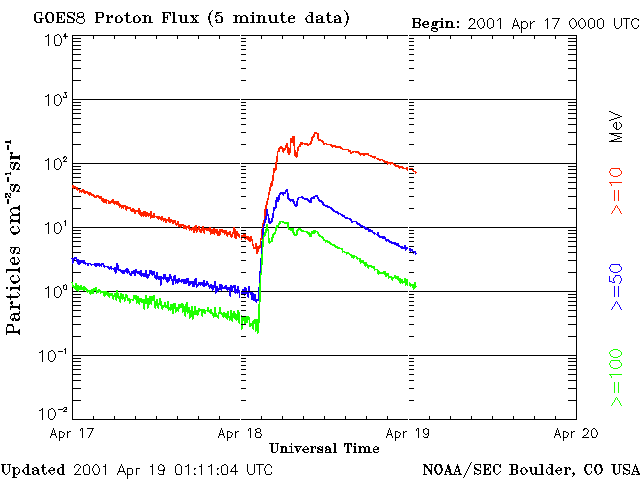
The SOHO spacecraft is sitting at L1, where it is exposed to high-energy particles from the Sun. An increase in the particle flux is easily seen on LASCO or EIT images, which get a lot of what is called "snow" on your TV. This week, such an increase happened right after the X14 flare (on 15-Apr-2001), with the particle flux staying high for long time. On the decay of this SEP event, there was another one on the 18th, as seen also in the following plot from NOAA (click to enlarge). It started around 3 UT.

Around this time, the GOES X-ray light curve showed only a minor (C2) flare (02:14 UT). So a questions arises: is this another example of a major particle event not associated with a major flare? A gradual and large particle event like this is known to be due to a shock driven by a CME. Voila, LASCO C2 data show a CME as early as 02:30 UT (in the SW direction). CMEs almost invariably leave a signature in the low corona, commonly known as "dimming" or a "transient coronal hole" if seen on disk. These topics have been talked about many times in these nuggets. Dimming is usually interpreted as mass depletion due to a CME. The dimming phenomenon is often more clearly seen in EIT than SXT images, probably reflecting the temperature of a large fraction of the ejected material being lower than 2.5 MK. The following figure shows an EIT difference image.
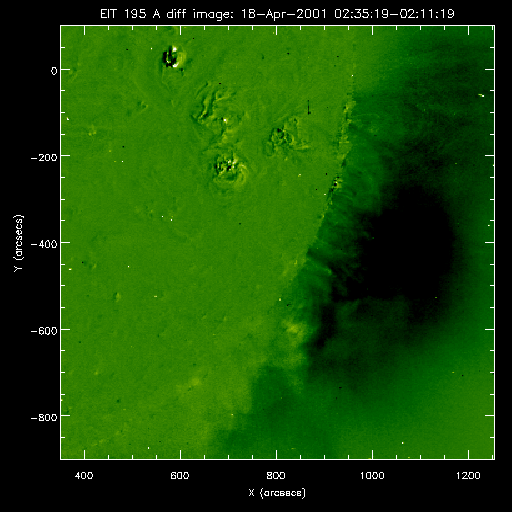
The SXT data coverage was quite poor around the time of the CME. But there was a pair (in quarter resolution) that could be used to make a difference image, as shown in the following figure.
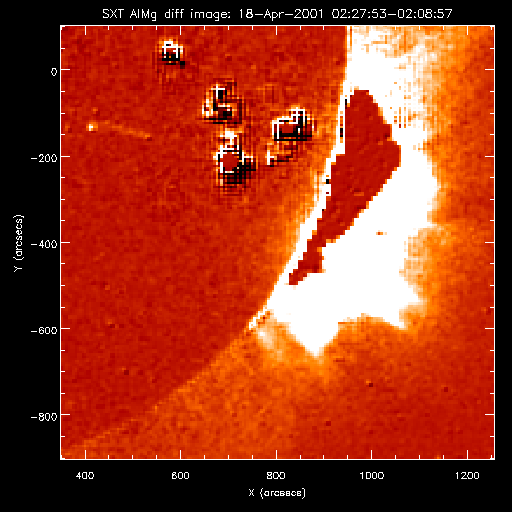
We do not see a clear sign of dimming. Instead, the EIT dimming area appears bright (the triangular feature embedded in the bright area is due to saturation). There are events where SXT dimming is more difficult to see, but we do not know of an event, where the EIT dimming area corresponds to the SXT brightening area. Strictly speaking, these areas are not exactly cospatial (the SXT brightening area is slightly lower), and the times of the two sets of images that were used to make difference images are not the same. The SXT "post-event" image was taken 8 minutes before the EIT counterpart. But this time difference may not turn the SXT brightening to dimming, since the CME must have already had started at 02:28, the time of the SXT image, to be observed at 02:30 UT. There is some possibility that the EIT dimming in this case does not stand for the mass taken out by the CME, but heating that makes the coronal plasma too hot to be seen by EIT. If there is > 10 MK plasma, EIT may see Fe XXIV emission, but its absence in this event would be easily explained in terms of a large volume and hence low density.
Then we naturally question where the source region of the CME was. We believe that the CME was associated with a big flare that were likely to have occurred in AR 9415. This is a super active region in terms of flare activity. Over its disk passage, it produced three X-class flares including X14 on the 15th, as seen in the extract of the NOAA preliminary event list. This region may have produced more M-class flares, whose locations happened to be unavailable when the list was compiled. SXT observed the X14 flare at 15 April 19:40 UT, and it was already very close to the limb with one of the foot-points of the flare loop was located at W86. Therefore the flaring area was already about 30 degrees behind the limb at 18 April 02:10 UT. This means that structures below 100,000 km were occulted by the limb. As a result, the flare looks quite unusual in several respects. The following plot shows the light curves from HXT (L-band, 14-23 keV), and GOES.
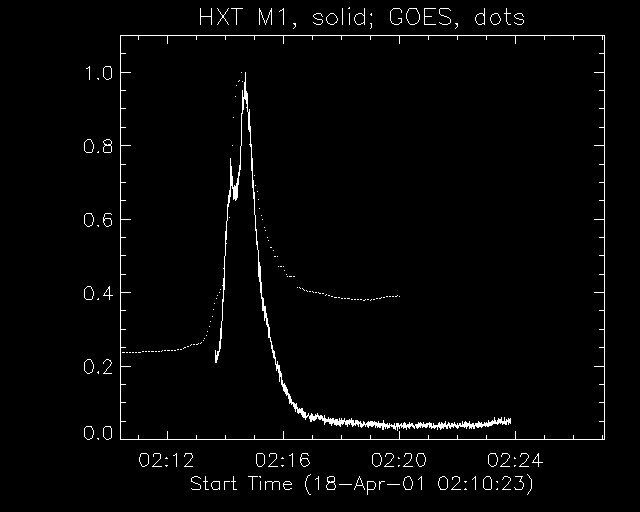
First, we know that soft X-ray emission in solar flares comes predominantly from loop structures far below 100,000 km, so what we see is a very small part of the entire flare. It is likely that the flare was much more intense, maybe comparable to the X14 flare. Another implication is that the flare may have started much earlier, since higher loops are predicted to become brighter at later times if we believe in the standard reconnection theory or cartoon. Therefore, even if the hard X-ray light curve looks normal, it may actually represent processes in the higher corona independent of the usual impulsive phase. Indeed, the hard and soft X-ray light curves do not appear to follow the relation, i.e., integration of the former mimics the latter. Moreover, the hard X-ray images show an unprecedented rapidly moving source (movie), which rises to a height approaching 200,000 km before becoming undetectable. The 17 GHz images from the Nobeyama Radio Heliograph (NoRH) also captured fast ejection in the form of a compact source, which some people may identify with a plasmoid in association with magnetic reconnection. See this mpeg movie. Also, click the following figure to see the relation between the microwave (grayscale) and hard X-ray (contours) sources at three times. After 02:16 UT, the HXT images do not appear to be converged, presumably because the source became too faint.
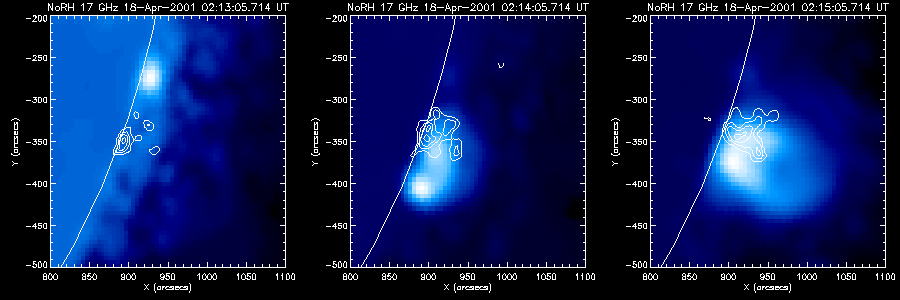
Whether the CME did originate from AR 9415, well behind the limb, rather than a hypothetical region closer to the limb, will have to be confirmed using other data. A piece of important information may be the starting frequency of the metric type II burst. It seems that both Culgoora and Hiraiso (CRL) observed it. We hope to study the burst in detail in the future, although presently the following plot copied from the CRL near real-time page does not allow us to do so.
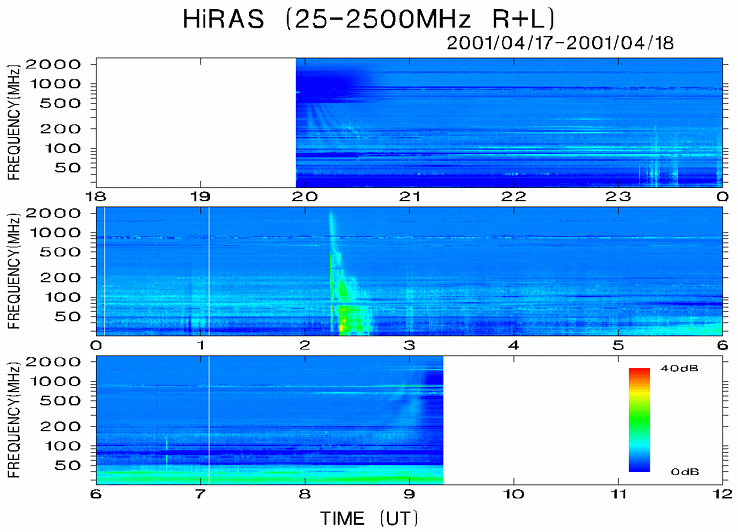
Speaking of the type II burst, the WIND/WAVES experiment observed an interplanetary (decametric) type II burst, as reported in a message from Mike Kaiser, who said it is not clear that this type II burst has the same origin as the metric type II burst.
This event is interesting, because it indicates that a back-side event can have effects at 1 AU with a shock that has wide longitudinal extension. It also gives us a chance to think more seriously about the 3-d nature of the CME. We are reminded that we do not really understand the exact nature of dimming.
Note: We now maintain a topic index of the Yohkoh science nuggets.
20 April, 2001